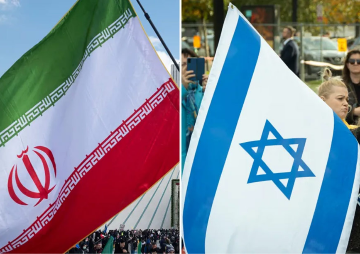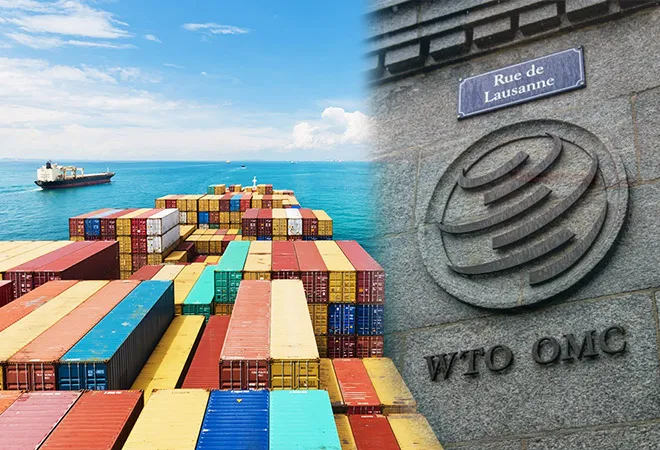
Global trade order jolted even before the pandemic
The year 2018 had been a watershed in the recent history of international trade. The United States unilaterally imposed tariffs on China on a range of goods, ostensibly to neutralise Chinese imports that threatened “national security”. The real objective, however, was to restrict competition from “
cheap metal that is subsidised by foreign countries” which led a dumping allegation.
China retaliated by
imposing tariffs on 128 American products worth US$ 3 billion in exports to China in 2017. This eventually led to a full-fledged trade war between these two nations. Other trade conflicts, such as that between Japan and South Korea, were also reignited in the aftermath. As tariff impositions were product-specific and not country-specific, other countries eventually joined the tussle. India also, perhaps unwillingly, got embroiled in this trade war, when the country
imposed higher duties on 29 key US imports in retaliation.
The United States unilaterally imposed tariffs on China on a range of goods, ostensibly to neutralise Chinese imports that threatened “national security”.
The international trade order, principally spearheaded by the WTO since 1995, was severely damaged by this chain of events. And then after the pandemic erupted by the end of 2019, the already dented international trade started experiencing more complex problems as lockdowns disrupted the global supply chain periodically.
Trade revival is resilient but highly uneven
Both merchandise and trade volumes showed a more resilient recovery in 2021, in comparison to the period after the 2008-09 Global Financial crisis (
Figure 1). However, the revival is mainly driven by merchandise trade whilst services continue to remain subdued.
| FIGURE 1: Global trade looks more resilient during COVID-19 pandemic than during 2008-09 global financial crisis |
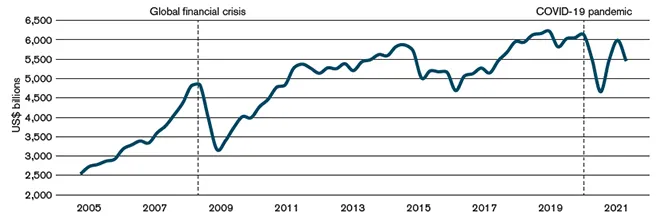 |
|
* The line diagram represents the evolution of non-seasonally adjusted quarterly world trade volume for countries that reported both merchandise and commercial services trade flows.
Source: World Trade Report 2021, WTO |
Overall trade recovery demonstrates
divergence in different regions of the world. Whilst Asia leads the rebound growth in both exports and imports, West Asia, South America, and Africa have the weakest recoveries in exports. On the import side, West Asia, the Commonwealth of Independent States (CIS) countries, and Africa are likely to have the slowest recoveries. Regions with more oil-reliant export bases went through drastic declines in both merchandise exports and imports during the 2020 pandemic-induced recession. These regions are yet to come out of those shortfalls. South America’s comparatively better import recovery is partly the result of a low base effect, as some key economies were already in recession during 2019.
| FIGURE 2: Global trade grows after pandemic but is likely to slow down in 2022 |
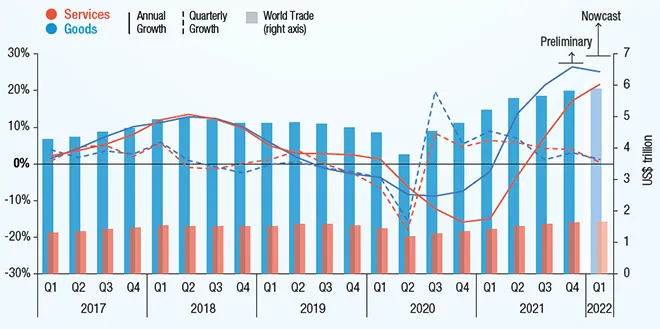 |
|
* Latest trade figures are UNCTAD calculations based on national statistics.
* Quarterly growth is the quarter over quarter growth rate of seasonally adjusted values, whilst annual growth refers to the last four quarters.
* Figures for Q4 2021 are preliminary; Q1 2022 is UNCTAD nowcast.
Source: Global Trade Update, February 2022, UNCTAD |
Volumes in trade in goods and services showed a strong surge in the first half of 2021, but the growth rate started slowing down in the second half. It is likely to further decelerate in 2022. Estimates by the UN Conference on Trade and Development (UNCTAD) hint in that direction (
Figure 2).
Whilst China’s trade surplus increased in 2021, the US trade deficit widened. Most of the least developed countries (LDCs) and developing countries also experienced a worsening trade deficit in 2021 (
Figure 3). This clearly shows the unevenness in global trade recovery.
| FIGURE 3: Global trade grows but trade imbalances also grow |
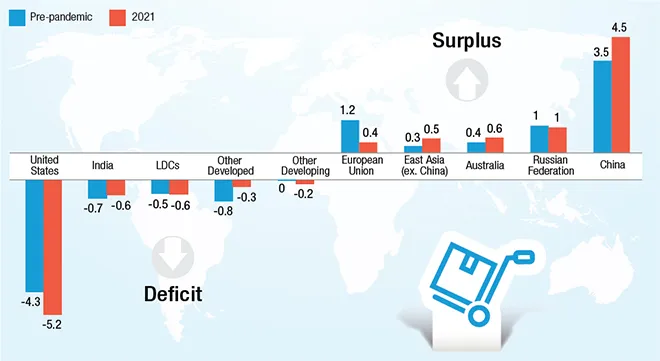 |
|
* Latest trade figures are UNCTAD calculations based on national statistics; data exclude services.
* Trade balance calculated as percentage of global trade.
Source: Global Trade Update, February 2022, UNCTAD |
Challenges to multilateralism at WTO
Unilateral tariff imposition and other trade restrictions before the pandemic not only gave rise to trade tensions but also undermined the multilateral trade order nurtured by the WTO. Indeed, there has been extraordinary growth in all kinds of global trade since the inception of WTO in 1995. The organisation played an important role in facilitating tariff reduction and ease of trading across countries.
However, the fault lines started appearing after some time. A prime example would be the gradual dismantling of the trade dispute settlement mechanism at the WTO. Years of US pressure have brought the international trade appeals system to a breaking point. In 2016, the Barack Obama administration decided to block the reappointment of a South Korean judge to the WTO's appellate body. The succeeding Donald Trump government continued the position and intensified the blocking of the appointment of judges in the body. As a result, the appellate body became defunct, as the tenures of two more judges expired and only one active judge remained by December 2019. Since its inception, seven judges serve on this body and a minimum of three judges are mandatorily required to review new appeals. The Joe Biden administration continues to block the new appointments, and
the appellate body remains paralysed.
Attempts to incorporate such larger global sentiments within the WTO are apparent, but they can jeopardise the multilateral character ingrained within the WTO.
Though big economies, including the US, have reiterated their commitment to the WTO, trade wars and unilateral decisions on tariff and non-tariff restrictive measures have undermined the role of the WTO in recent times. This was preceded by the stalemate in the Doha Round of negotiations due to a lack of consensus on issues related to agricultural subsidies and information technology products.
The WTO is also aware of emerging trends in bilateral and plurilateral trade agreements. Attempts to incorporate such larger global sentiments within the WTO are apparent, but they can jeopardise the multilateral character ingrained within the WTO.
Uncertain global trade order
Before the pandemic, some of the mega Free Trade Agreements (FTAs) in news included Trans-Pacific Partnership (TPP) and Regional Comprehensive Economic Partnership (RCEP). A huge volume of combined GDP and market size of the countries involved in initial discussions prompted many to consider these two mega FTAs as the future of international trade.
However, the withdrawal of the USA from TPP in 2017 and India from RCEP in 2019 drastically reduced the combined market size of both these FTAs. Though CPTPP entered into force in December 2018 (for the first six ratifying countries) and
RCEP came into force in January 2022 (for the first ten ratifying countries), the withdrawal of the US and India took away substantial heft of the original proposed economic strength of these free trade zones.
Worldwide inflation raised the fear of a probable recession, the ongoing Russia-Ukraine war is likely to result in new political and economic implications, China’s zero-tolerance policy towards COVID-19 already wreaked havoc on global supply chains and the country is also currently facing an economic slowdown.
Therefore, after the pandemic, the focus has largely shifted toward bilateral trade and investment treaties. Meanwhile, there have been drastic geopolitical and subsequent economic shifts that occurred in the last two years. Worldwide inflation raised the fear of a probable recession, the ongoing Russia-Ukraine war is likely to result in new political and economic implications, China’s zero-tolerance policy towards COVID-19 already wreaked havoc on global supply chains and the country is also currently facing an economic slowdown.
Repercussions of these major international phenomena will be extremely uncertain and fluid. So, the immediate focus of developing countries and emerging economies, including India, should be to remain vigilant and flexible whilst at the same time protecting their individual trade interests. Safeguarding individual trade interests, in turn, will principally depend upon creating and implementing as many beneficial bilateral trade and investment agreements as possible.
The views expressed above belong to the author(s). ORF research and analyses now available on Telegram! Click here to access our curated content — blogs, longforms and interviews.







 PREV
PREV


